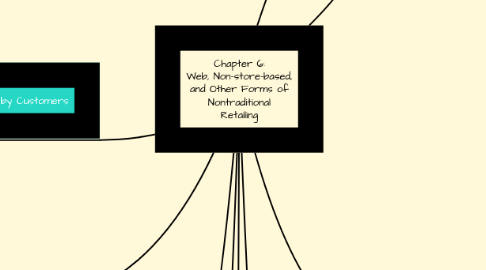
1. Media Selection
1.1. Printed catalogs
1.2. Direct-mail ads and brochures
1.3. Inserts with monthly credit card and other bills (statement stuffers)
1.4. Freestanding displays
1.5. Ads or programs
2. Outcome measures
2.1. Overall response rate
2.2. Average purchase amount
2.3. Sales volume by product category
2.4. Value of list brokers
3. Selection Factors by Customers
3.1. Availability of toll-free phone number or Web site for ordering
3.2. Ability to shop whenever consumer wants
3.3. Types of goods and services
3.4. Satisfaction with past purchases and good return policy
3.5. Credit card acceptance
3.6. Speed of promised delivery time
3.7. Company reputation and image
4. Emerging Trends
4.1. Evolving activities
4.2. Changing customer lifestyles
4.3. Increasing competition
4.4. Increasing usage of dual distribution channels
4.5. Changing media roles, technological advances and global penetration
5. Data-Base Retailing
5.1. Collection, storage, and usage of relevant customer information
5.1.1. Name
5.1.2. Address
5.1.3. Background
5.1.4. Shopping Interests
5.1.5. Purchase Behaviour
5.2. 80-20 Rule (The Pareto Rule)
6. Direct Marketing
6.1. Customer exposed to a product through non-personal medium and then orders by mail or phone.
6.1.1. Advantages
6.1.1.1. Reduced Costs
6.1.1.2. Lower Prices
6.1.1.3. Large geographic coverage
6.1.1.4. Convenient to customers
6.1.1.5. Ability to pinpoint customer segments
7. Approaches to Retailing Channels
7.1. Single Channel Retailing
7.1.1. Store-Based
7.1.2. Mail Ordering
7.1.3. Online CD retailer
7.2. Multi Channel Retailing
7.2.1. Store-based retailer also operating through internet ordering
8. THE WEB
8.1. The role of the web
8.1.1. Provide customer service
8.1.2. Be more personal with customrs
8.1.3. Conduct a retail business efficiently
8.1.4. Get feedback
8.1.5. Promote special offers
8.1.6. Describe employment opportunities
8.1.7. Present information to potential investors, franchisees, and the media
8.2. Figure 6-9: A Checklist of Retailer Decisions in Utilizing the Web
8.3. Web Strengths
8.3.1. Using the Web: information, entertainment, communications
8.3.2. Shopping online: selection, prices, convenience and fun
8.4. Reasons not to shop online
8.4.1. Trust
8.4.2. Fear
8.4.3. Lack of security
8.4.4. Lack of personal communication and seeing the products live
8.5. Recommendations for web retailers
8.5.1. Develop or exploit a well-known, trustworthy retailer name
8.5.2. Tailor the product assortment for Web shoppers
8.5.3. Enable the shopper to click as little as possible
8.5.4. Provide a solid search engine
8.5.5. Use customer information

